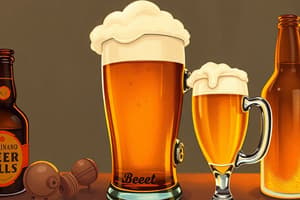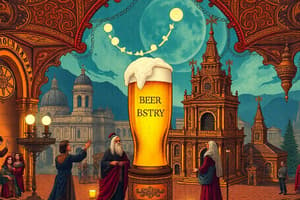Podcast
Questions and Answers
In which country did Pilsners originate?
In which country did Pilsners originate?
What is the purpose of boiling the wort in the beer brewing process?
What is the purpose of boiling the wort in the beer brewing process?
When can the origins of beer be traced back to?
When can the origins of beer be traced back to?
What raw materials are typically used in the production of beer?
What raw materials are typically used in the production of beer?
Signup and view all the answers
Which type of yeast is typically used in the brewing of ales?
Which type of yeast is typically used in the brewing of ales?
Signup and view all the answers
How did monks contribute to the brewing process during the Middle Ages?
How did monks contribute to the brewing process during the Middle Ages?
Signup and view all the answers
What distinguishes stouts from other beer styles?
What distinguishes stouts from other beer styles?
Signup and view all the answers
What significant role did the Industrial Revolution play in brewing?
What significant role did the Industrial Revolution play in brewing?
Signup and view all the answers
What drives the craft beer movement?
What drives the craft beer movement?
Signup and view all the answers
Which innovation helped improve the shelf life of beer?
Which innovation helped improve the shelf life of beer?
Signup and view all the answers
How do lagers differ from ales in terms of fermentation?
How do lagers differ from ales in terms of fermentation?
Signup and view all the answers
What was a key advancement in brewing processes driven by scientific advancements?
What was a key advancement in brewing processes driven by scientific advancements?
Signup and view all the answers
Study Notes
Beer: An Alcoholic Beverage with History and Variety
Beer is an alcoholic beverage that dates back thousands of years. Produced by extracting raw materials such as malted barley, hops, and water, then boiling and fermenting, beer has become a global phenomenon enjoyed by millions of people across various cultures. In this article, we will delve deeper into the history, brewing process, and types of beer, providing you with an understanding of what makes this beverage so popular and beloved.
History of Brewing
The origins of beer can be traced back to 6000 BCE in Sumer and Babylonia, where beer was originally made from barley without the use of hops. Over time, techniques improved, with barley being stored in wet conditions to encourage the growth of natural yeasts. Around 3500 BCE, brewing techniques progressed further, leading to the production of more complex beers with a higher alcohol content.
During the Middle Ages, monasteries played a significant role in preserving brewing as a craft. Monks refined the process, introducing new ingredients like hops, which helped to stabilize the beer and improve its shelf life. The craft of brewing continued to evolve throughout the centuries, with innovations such as the use of pure yeast cultures and improvements in brewing processes driven by scientific advancements.
In the modern era, the Industrial Revolution led to the mechanization of brewing, making it easier to mass produce beer. Today, brewing is a large-scale industry, with modern breweries using advanced technologies and packaging options.
Brewing Process
Although the exact brewing process varies slightly depending on the beer's intended style, the core components remain the same. Here is a simplified version of the typical brewing process:
- Milling: The grains, usually made from barely, are ground into smaller particles called grist.
- Mashing: The grist is combined with hot water, which activates enzymes within the barley, breaking down the starches into fermentable sugars. This mixture is called 'wort'.
- Boiling: The wort is boiled for a specific period to sterilize it and add flavorings such as hops.
- Cooling: After boiling, the wort is cooled to a suitable temperature for fermentation.
- Fermentation: Yeast is added to the cooled wort, which converts the sugar into alcohol and carbon dioxide.
- Conditioning: Once fermentation is complete, the beer is aged or 'conditioned' to allow flavors to develop fully.
- Packaging: Finally, the beer is packaged, either in kegs, bottles, cans, or other containers, and distributed for sale.
There are two primary categories of beer: ales and lagers. Ales are typically brewed using top-fermenting yeast at elevated temperatures, resulting in faster fermentation times and producing a wider range of flavors. On the other hand, lagers require bottom-fermenting yeast and lower temperatures, leading to slower fermentation but a cleaner, crisper flavor profile.
Popular Styles of Beer
Some popular beer styles include:
- Pilsners: Light in color with a high level of hoppy bitterness. Originating in the Czech Republic, they are characteristically fruity and floral.
- India Pale Ales (IPAs): Often brewed with high levels of hops, giving them a strong bitterness and hoppy flavor. They are particularly popular in the United States.
- Stouts: Dark beers with a rich body and intense flavors, often featuring notes of coffee or chocolate.
- Porters: Similar to stouts but lighter in color, with distinct roasted malt flavors.
Craft Beer Movement
In recent years, there has been a surge in interest in craft beer, driven by small-scale producers who emphasize quality over quantity. These breweries often experiment with unique ingredients and flavors, leading to an increased variety of styles available for consumers to enjoy.
Conclusion
Beer is more than just an alcoholic drink; it's a reflection of human history, culture, and innovation. From ancient civilizations to modern industrial processes, beer has evolved into a diverse range of styles that cater to all taste preferences. Whether you're a fan of traditional lagers or prefer the boldness of craft ales, there's a beer out there to suit every palate. So raise your glass to this timeless beverage and toast to its rich history and enduring popularity.
Studying That Suits You
Use AI to generate personalized quizzes and flashcards to suit your learning preferences.
Description
Test your knowledge on the history, brewing process, and popular styles of beer with this quiz. Explore the origins of beer, the steps involved in brewing, and the characteristics of different beer styles. Whether you're a beer enthusiast or simply curious about this beloved beverage, this quiz will provide insights into the world of beer.




